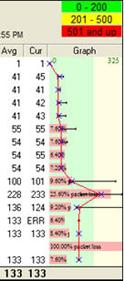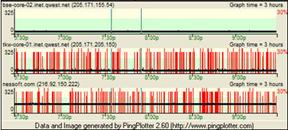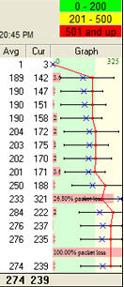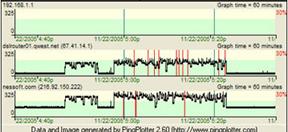VoIP troubleshooting-Internet
VoIP is dependant on both the local and wide area network. If voice quality problems occur, either for brief periods or longer durations the problem can often be the direct result of the network connection. This would include your ISP Internet Service Provider or some other component between you and the party that you are talking with.
Some issues are probably not a network related problem. One would be constant echo on your VoIP line, although a network issue could make this echo worse over certain periods. Another would be the inability not to connect to specific phone numbers. For other consistent voice quality issues we recommend looking at out VoIP tutorials first.
VoIP symptoms of network issues.
Many quality issues with your VoIP connection could be the direct result of network problems. Although these issues could be the result of something else other than network related problems, they are highly indicative of one, especially if your VoIP connection works well most of the time and then experiences problem periods. These symptoms are:
- Bits of voice or words missing.
- Sound (voice) distortion including strange background noises like clicks, ticks, pops or high pitched clangs, etc..
- Delays between the time that you speak and when the other side hears you words, (and vice versa).
- Talking over each other because neither end realizes the other already started speaking.
- Gaps of missing voice.
Causes of poor quality VoIP.
The network related causes of poor quality VoIP as described by the symptoms above, can be broken down into three main categories.
Data packets carrying parts of a conversation can be lost during transmission. If enough packets are lost, and VoIP is very sensitive to and has a very low threshold to packet loss, then gaps or audible problems will quickly be discernible. The protocols or codecs that are used to transport voice often incorporate Packet Loss Concealment, which will help mask the effects of lost or discarded packets, but they cannot overcome even low percentages of packet loss.
The difference in the transit time of packets varies and this difference is called Jitter. As the packets of voice need to arrive in the same order as they were sent, variation will result in a out of sequence part of sound which if not placed in the proper order would make nonsense sound rather than distinguishable words. An IP phone or ATA has a built in Jitter Buffer that introduces a small amount of delay in order to smooth out and sequence these timing variations, but only has a limited capability. (Actually this jitter buffer translates jitter into additional delay and packet loss. Which is another reason VoIP is very sensitive to Jitter.) If some packets arrive too late then they may be entirely discarded producing the bitts of lost voice.
Latency or delay is the amount of time it takes data to travel from one endpoint to the other endpoint. This travel time depends on several factors including distance, queuing delay, which is the amount of time packets are held in a queue because of congestion on an outbound interface of a device (router), and handling delay which is the result of devices that forward the frame through the network. VoIP depends on RTP traversing in a reasonable amount of time (milliseconds), some people say typically no more than 150ms, but conversations can still be good at the 200-220ms traverse time if other network issues are not a problem (packet loss, jitter). VoIP users will probably notice round-trip delays that exceed 250ms. Above 250ms and callers will begin talking over each other. Around the 500ms range phone calls become impractical and anyone carrying on a conversation with this amount of latency had better end each sentence with "over".
How to network troubleshoot VoIP
To troubleshoot VoIP and the Internet or WAN network that the data is traversing use a good free tool; PingPlotter. Using PingPlotter place the IP address of the providers SIP server as the target address. The resulting graph can be used to locate packet loss at the end targets IP.

Always look at the final destination first, and see if it is registering packet loss. Then look at each upstream hop for the first one (closest to the last hop) that does not show a similar loss. The packet loss problem would then reside between the good hop and the bad hop (hand off).

If you're not seeing any packet loss at the final destination then the other intermediate hops shouldn't be of any concern regarding packet loss. But they could be introducing latency or delay at which point they would be of concern.
 Congestion can be recognized by looking at a PingPlotter
graph. This event can have detrimental effects on VoIP as the
congestion introduces latency and packet loss. Some nodes on
cable systems can be over subscribed and during peak hours experince
congestion. Typically peak hours would be between 6PM and 9PM.
Congestion can be recognized by looking at a PingPlotter
graph. This event can have detrimental effects on VoIP as the
congestion introduces latency and packet loss. Some nodes on
cable systems can be over subscribed and during peak hours experince
congestion. Typically peak hours would be between 6PM and 9PM.

If packet loss is accompanied by a high level of jitter then congestion could be the problem. Or if packet loss comes and goes in large amounts (known as bursty) then the problem might also be network congestion.


